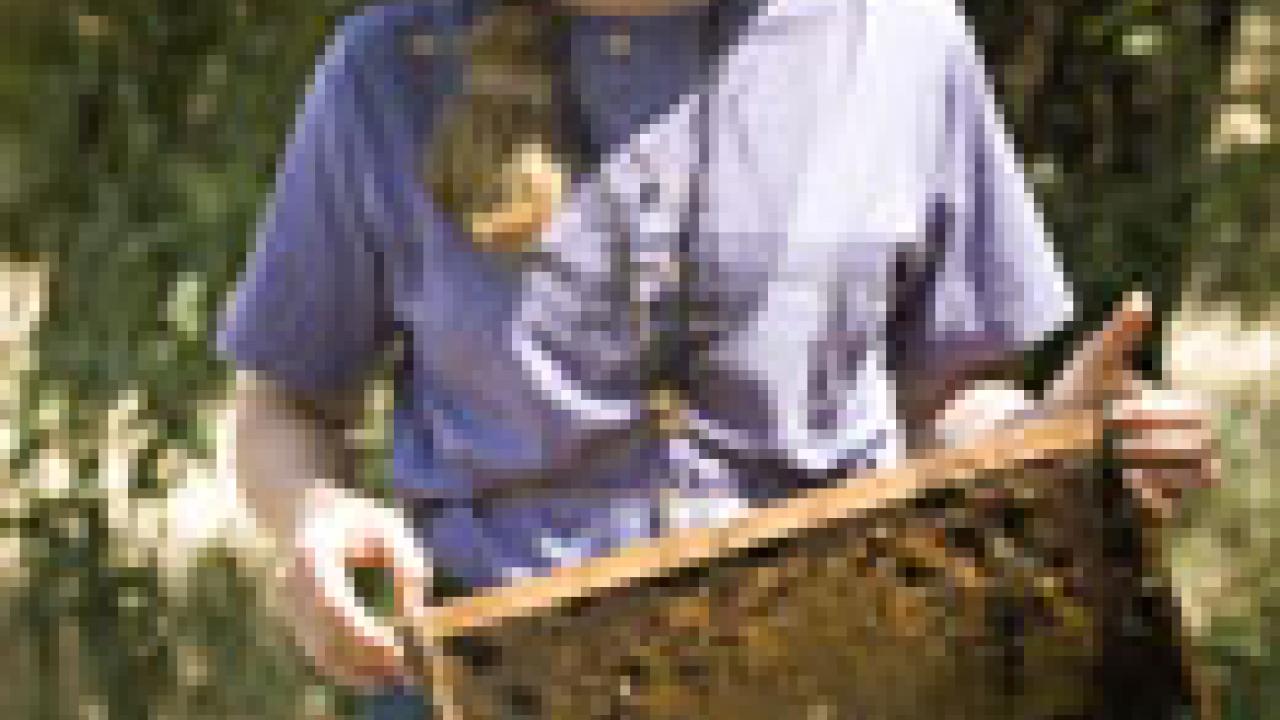The gravity of this year's mass honey bee exodus from hives across the nation depends on who you are and where you live, suggests Eric Mussen, a Cooperative Extension bee expert at UC Davis' bee biology facility.
If you are the Washington beekeeper who had only eight of his 4,000 bee colonies survive the winter, the disappearing bee phenomenon, known as Colony Collapse Disorder, is a disaster of major proportions.
But if you are a California almond grower, you have reason to be optimistic: This spring's weather was mild, there were enough honey bees to pollinate the state's almond trees, and this year's crop is expected to tip the scales at a record 1.2 billion pounds.
Almonds trees, planted on 600,000 acres in northern and central California, produce one of state's most lucrative crops. Almonds, cherries, sunflowers, alfalfa and a host of other crops depend on honey bees to transport pollen from blossom to blossom.
Each year, professional beekeepers truck hundreds of thousands of white-boxed colonies of honey bees into California so the bees can play their brief but critical role in the state's agricultural industry.
Late last fall, beekeepers in the eastern United States began to report the disappearance of bees. The situation worsened during the winter months and spread to 27 states, including California.
For decades, beekeepers were accustomed to losing 5 percent to 10 percent of their bees during the winter. When the tiny, but devastating, Varrroa mite appeared on the scene in the 1980s, winter losses climbed to 15 percent to 25 percent. This year, however, some beekeepers saw winter die offs as high as 30 to 60 percent.
"That's not good from a beekeeper's perspective," said Mussen.
A team of researchers from Penn State, the University of Montana and the U.S. Department of Agriculture's Beltsville, Md., headquarters quickly fanned out across the country. Although they have extensively sampled bees and bee food, they have yet to discover the cause of the die offs.
"Colony collapse is a complex problem," said Susan Cobey, a well-known bee breeder and geneticist who was recently hired to manage the campus's Harry Laidlaw Jr. Honey Bee Research Facility. Cobey worked during the late 1970s and early 1980s in the bee biology lab, where the late Professor Harry Laidlaw inspired her career choice.
Several theories offering possible causes for the collapse have taken shape, including one suggesting that pesticides known as neonicotinoids may be finding their way into pollen and subsequently erasing the bees' memory, disrupting their ability to navigate from hive to plant and back again. Mussen thinks this deserves further research, but notes that residues encountered by foraging bees of imidacloprid, one of the pesticides of particular concern, have been at concentrations that have not been proven to kill colonies of honey bees.
And then there is a theory suggesting that pollen from plants that have been genetically modified to produce the biological pesticide bacillus thuringensis, or BT, might be to blame. Still another theory speculates that radio waves from cell phones might be disrupting bee navigation. Research offers little evidence to support either of these propositions, Mussen said.
He noted that researchers found one virus among bees imported from Australia that merits further study. However, he pointed out that honey bees already carry 11 latent viruses, which become active only under certain stressful conditions. He suspects the cause is more likely a nutrition.
Certainly, this year's drier than normal rainy season has resulted in a shortage of the wild plants that honey bees depend on for food.
"Beekeepers say this is the worst they have seen," said Cobey.
Despite the unsolved mystery of Colony Collapse Disorder and the unusually dry year, she and Mussen remain optimistic. Beekeepers have periodically recorded similar die offs as early as the 1890s and as recently as 2005, they note.
As researchers elsewhere probe the causes of Colony Collapse Disorder, Cobey and Mussen have their hands full providing information to California's 200-plus beekeepers and rebuilding UC Davis' once robust bee biology program.
The 65-year-old program — the oldest of its kind in the nation — was decimated during the 1990s by retirements and budget cuts. Through the program's lean years, Mussen continued as a much sought-after source of reliable information for the state's beekeepers.
Cobey will be restoring the bee biology facility's colonies, which dwindled from 250 to just 30, and soon a new faculty member specializing in pollination research is expected to be hired.
With her expertise in bee genetics and breeding, Cobey has already begun offering specialized classes to bee breeders in an effort to help them improve the hardiness of their bee stock.
Such long-range strategic solutions, rather than "desperate quick fixes," are needed to turn the tide for the honey bees and the agricultural industries they support, she said.
Media Resources
Clifton B. Parker, Dateline, (530) 752-1932, cparker@ucdavis.edu
